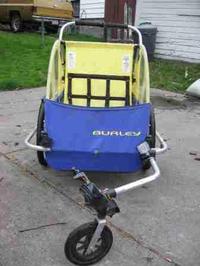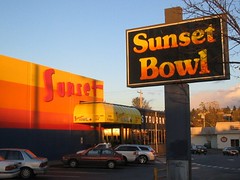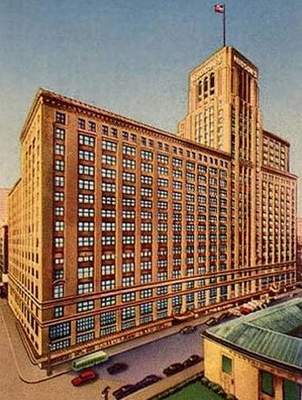Living without a car, local commerce and the "walkshed"
Alan Durning is the director of Northwest Environment Watch. (Before that he worked at DC's WorldWatch Institute and wrote many of their monographs.) Recently, his car broke down, permanently, and rather than replace it, he decided to see how long his family can do without a car.
In the latest installment about this "journey," he discusses their use of an old stroller-bike trailer to tote groceries and the like, and the range where this is practical. From the blog entry:
Last week, I displayed the wreckage of our 1986 stationwagon; this week, its replacement: our 1996 Burley stroller/bike trailer. The kids have long-since outgrown the thing. But since we decided to experiment in car-less living, we’ve resurrected it to haul groceries, library books, and (recently) a broken vacuum cleaner.
 The Durnings' Burley stroller.
The Durnings' Burley stroller.The Burley’s range is only as far as you want to push it. And for my family, that limit seems to be about one mile. Less than a mile is a comfortable walk; more is a burden. (To extend the range, we can fit the Burley to a bicycle—on which, more another day.)
A one-mile perimeter, therefore, defines this car-less family’s pedestrian travel zone—call it our “walkshed.” Fortunately, because we chose to live in a compact community, our walkshed turns out to be well stocked. We can stroll to scores of shops and services—248 to be precise. I know because I counted. You can, too, in less than 60 seconds. I’ll tell you how in a moment.
Among the establishments in our domain are a bowling alley, a produce stand, a movie theater, and a hardware store, plus public institutions such as our post office, swimming pool, farmers’ market, and skate park (new and very cool!).
We’ve got pairs of independent booksellers, thrift stores (we know them well), and bakeries (ditto). Three pharmacies, three yoga studios, and three video stores offer us medication, meditation, and mesmerization, respectively. Five grocers and six dry cleaners compete for our appetites and our wrinkles. Nine barbers eye our locks. Dozens of specialty shops hawk their curiosities in the range of our Burley: one sells only flags, another only gifts from Norway, a third only old magazines.
 Sunset Bowl in the Durnings neighborhood. (Photo from Seattlest.)
Sunset Bowl in the Durnings neighborhood. (Photo from Seattlest.)True coffee houses number six, only one of them a Starbucks (which, because it's so low, may be the most surprising number in this tally). Restaurants? We’re provisioned with 54! (And there are 151 within two miles: we’ll walk farther for great eating.) Two neighborhood ice creameries...
That's a lot of retail...
I haven't been to Seattle (I plan to visit next year), but last fall I visited Portland and wrote a fair amount about the experience (e.g., "More about Portland, historic preservation, retail vibrancy, and and urban growth boundaries" and "The Last Word, not mine, on Portland's Dynamic retail environment") especially about the amount of independent retail.
I posited this was due in part to Urban Growth Boundaries restricting the ability of big box retail to plop willy-nilly in the retail trade area.
But I guess a part of it has to do with the relative homogeneity of Portland, and the same for Seattle, and the fact that over the past 40 years, Seattle's population was relatively stable, or in the case of Portland, population actually increased by 50%.
This was the exact opposite of the experience of eastern center cities, which experienced tremendous outmigration for a variety of reasons, including "white flight." (For example, while the three county region of Detroit grew "only" 200,000 in population over the past 40 years--and the out-counties grew much more--1.1 million people moved out of Detroit and into the counties.)
Among the many deleterious effects were the impacts on urban retail, particularly local independents and regional (but small) chains. And we all know what happened to department stores.
The Durning experience confirms the point made by Alex Wall, that commerce drives urbanity and vice versa. (See Victor Gruen: From Urban Shop to New City.)
 J.L. Hudson's Dept. Store, Detroit (postcard). Since demolished. See this story, "How J.L. Hudson changed the way we shop," from the Detroit News history section, "Rearview Mirror," about the history and one-time impact of Hudson's Department Stores in Detroit.
J.L. Hudson's Dept. Store, Detroit (postcard). Since demolished. See this story, "How J.L. Hudson changed the way we shop," from the Detroit News history section, "Rearview Mirror," about the history and one-time impact of Hudson's Department Stores in Detroit.Index Keywords: walking; retail



0 Comments:
Post a Comment
<< Home